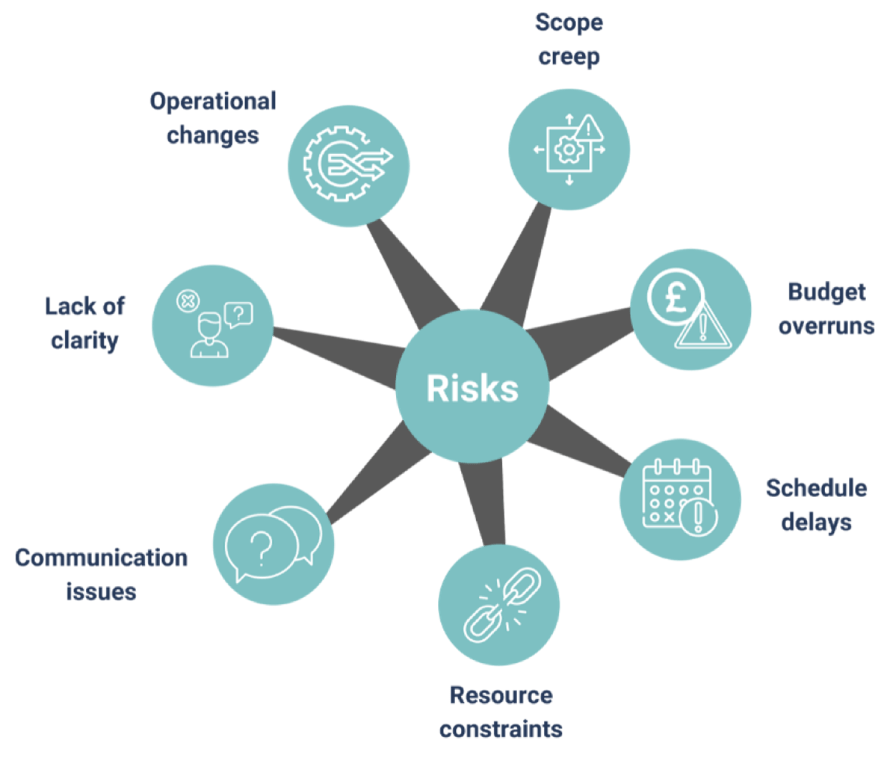
Introduction
Project management is a complex endeavour fraught with potential pitfalls. Risk management stands as a crucial component in ensuring project success. By identifying, assessing, and mitigating risks, project managers can steer their initiatives towards successful completion.
This article explores the risks that typically occur on projects and offers strategies to navigate them effectively. We’ll cover:
- Understanding project risks
- Common project risks
- The risk management process
- Tools and techniques for risk management
- Strategies for risk mitigation
- Best practices for effective risk management.
By the end of this article, you’ll be equipped with the knowledge to:
- Identify potential risks in your projects
- Implement effective risk management strategies
- Increase the likelihood of project success.
You can learn more about project risk management by attending a project management course – either a PRINCE2 course or APM course.
Let’s begin our exploration of project risk management and learn how to safeguard your projects against potential threats.
Understanding project risks
Definition of project risk
A project risk is an uncertain event or condition that, if it occurs, can have a positive or negative effect on project objectives. These events can impact scope, schedule, cost, or quality.
Types of project risks
Project risks can be categorised into several types:
- Internal risks: Originate within the project or organisation
- External risks: Arise from factors outside the project’s control
- Technical risks: Related to technology or project methodology
- Financial risks: Impact the project’s budget or funding
- Operational risks: Affect day-to-day project activities
- Strategic risks: Influence the project’s alignment with business goals.
Impact of risks on project success
Risks can significantly affect project outcomes:
- Positive impacts: Opportunities for innovation or efficiency gains
- Negative impacts: Delays, cost overruns, or quality issues.
Risk management is essential for minimising negative consequences, capitalising on potential opportunities and ensuring project objectives are met.
By understanding and anticipating risks, project managers can develop strategies to address potential issues proactively. This approach increases the likelihood of project success and delivers value to stakeholders.
Common project management risks

Scope creep
Common causes
Scope creep refers to uncontrolled expansion of project requirements. Common causes include poorly defined initial objectives, lack of change control processes, Stakeholder pressure for additional features and insufficient stakeholder engagement.
Impact
Scope creep can significantly affect project outcomes:
- Increased costs and resource demands
- Extended timelines
- Reduced quality of deliverables
- Team burnout and decreased morale.
To mitigate scope creep, establish clear project boundaries and implement robust change management processes.
Budget overruns
Common causes
Budget overruns occur when project costs exceed initial estimates. Common causes include inaccurate cost estimation, scope changes, unforeseen expenses and poor resource management.
Impact
Budget overruns can lead to reduced project profitability, strained relationships with stakeholders, compromised project quality and potential project cancellation.
To prevent budget issues, conduct thorough cost analyses and maintain transparent financial reporting throughout the project.
Schedule delays
Common causes
Schedule delays can arise from various factors:
- Unrealistic time estimates
- Resource unavailability
- Dependency conflicts
- External factors (e.g., weather, supplier delays).
Impact
Schedule delays can result in missed deadlines and milestones, increased costs due to extended project duration, reduced stakeholder satisfaction and potential loss of competitive advantage.
Implement effective project scheduling techniques and regularly monitor progress to mitigate time-related risks.
Resource constraints
Types of resource risks
Resource risks encompass various challenges:
- Skill shortages
- Equipment or material unavailability
- Insufficient funding
- Limited time availability.
Impact on project performance
Resource constraints can lead to reduced productivity, compromised quality of deliverables, increased stress on team members and potential project delays.
Conduct thorough resource planning and maintain open communication with stakeholders to address resource-related issues proactively.
Communication issues
Importance of effective communication
Effective communication is crucial for project success. It ensures alignment of project objectives, timely issue resolution, stakeholder engagement and buy-in and efficient team collaboration.
Consequences of poor communication
Inadequate communication can result in misunderstandings and conflicts, missed opportunities for problem-solving, reduced team morale and productivity and stakeholder dissatisfaction.
Establish clear communication channels and protocols to foster open and transparent dialogue throughout the project.
Lack of clarity
Sources of unclear requirements
Unclear requirements can stem from ambiguous project objectives, insufficient stakeholder input, lack of detailed documentation and changing business needs.
Effects on project outcomes
Lack of clarity can lead to misaligned expectations, rework and wasted resources, delayed decision-making and compromised project quality.
Invest time in gathering and documenting clear requirements, and maintain ongoing stakeholder engagement to ensure alignment.
Operational changes
Types of operational risks
Operational changes can include:
- Organisational restructuring
- Process modifications
- Technology upgrades
- Regulatory changes.
Impact on project execution
Operational changes can affect projects by disrupting established workflows, requiring additional training or resources, altering project priorities and necessitating scope or timeline adjustments.
Stay informed about potential organisational changes and maintain flexibility in project planning to accommodate operational shifts.
By understanding these common project management risks, you can develop targeted strategies to address them. Proactive risk management involves:
- Regular risk assessments
- Clear communication with stakeholders
- Robust change management processes
- Continuous monitoring and adaptation.
Remember, effective risk management is an ongoing process that requires vigilance and adaptability throughout the project lifecycle. By anticipating and addressing these common risks, you can significantly increase your chances of project success.
Risk management process
Risk identification
This initial stage involves recognising potential threats to your project. Methods include:
- Brainstorming sessions with team members
- Reviewing historical data from similar projects
- Conducting stakeholder interviews
- Analysing project documentation.
Create a comprehensive risk register to document all identified risks.
Risk assessment and prioritisation
Once risks are identified, assess their potential impact and likelihood of occurrence. Use tools such as:
- Risk matrix: Plot risks based on probability and impact
- Quantitative analysis: Assign numerical values to risks
- Qualitative analysis: Categorise risks based on severity.
Prioritise risks to focus on those with the highest potential impact.
Risk response planning
Develop strategies to address each prioritised risk. Common response strategies include:
- Avoidance: Eliminate the threat by changing project plans
- Mitigation: Reduce the probability or impact of the risk
- Transfer: Shift the risk to a third party (e.g., insurance)
- Acceptance: Acknowledge the risk and prepare contingency plans.
Document these strategies in your risk management plan.
Risk monitoring and control
Continuously monitor risks throughout the project lifecycle. This involves:
- Regular risk reviews and updates
- Tracking risk triggers and early warning signs
- Implementing planned responses when necessary
- Evaluating the effectiveness of risk responses.
Adjust your risk management approach as needed based on new information and changing project conditions.
By following this structured process, you can effectively manage risks and increase your project’s chances of success.
Tools and techniques for project risk management
Risk register
A risk register is a comprehensive document that records identified risks, their potential impact, and mitigation strategies. Key components include:
- Risk description
- Probability and impact assessment
- Risk owner
- Mitigation strategies
- Contingency plans.
Regularly update your risk register to maintain its relevance throughout the project lifecycle.
SWOT analysis
SWOT analysis helps identify internal and external factors that may affect your project:
- Strengths: Project advantages
- Weaknesses: Areas for improvement
- Opportunities: Potential benefits
- Threats: Possible risks.
This technique provides a holistic view of your project’s risk landscape.
Brainstorming sessions
Facilitate structured brainstorming sessions with your team to identify potential risks. Encourage open dialogue and creative thinking. Use techniques such as:
- Nominal group technique
- Affinity diagramming
- Mind mapping.
These sessions can uncover risks that might otherwise go unnoticed.
Project management software
Utilise project management software to streamline risk management processes. Look for features like:
- Risk tracking and monitoring
- Automated alerts for risk triggers
- Collaboration tools for team communication
- Reporting capabilities for stakeholder updates.
These tools can significantly enhance your ability to manage risks effectively throughout your project.
Strategies for mitigating common project risks
Preventing scope creep
- Define clear project boundaries in the initial planning phase
- Implement a robust change control process
- Educate stakeholders on the impact of scope changes.
Managing budget risks
- Conduct thorough cost estimation and include contingency funds
- Regularly monitor and report on budget performance
- Implement cost control measures and prioritise essential expenses.
Addressing schedule delays
- Use critical path analysis to identify key milestones and dependencies
- Build buffer time into project schedules
- Regularly review and adjust timelines based on progress.
Optimising resource allocation
- Conduct comprehensive resource planning at project outset
- Utilise resource levelling techniques to balance workloads
- Maintain a skills inventory to quickly identify and address gaps.
Improving communication
- Establish clear communication channels and protocols
- Schedule regular team meetings and stakeholder updates
- Utilise collaboration tools to facilitate information sharing.
Ensuring clarity in project requirements
- Conduct thorough requirements gathering sessions with stakeholders
- Create detailed, unambiguous project specifications
- Implement formal requirements review and approval process.
Adapting to operational changes
- Maintain awareness of potential organisational changes
- Build flexibility into project plans to accommodate shifts
- Develop contingency plans for significant operational disruptions.
By implementing these strategies, you can significantly reduce the impact of common project risks. Remember that risk mitigation is an ongoing process. Regularly review and adjust your approach to ensure continued effectiveness throughout the project lifecycle.
Best practices for effective risk management
Proactive approach to risk identification
- Anticipate potential risks early in the project lifecycle
- Encourage team members to report potential issues promptly
- Utilise historical data and lessons learned from previous projects.
Regular risk assessment
- Conduct periodic reviews of identified risks and their status
- Reassess risk priorities as project circumstances evolve
- Update risk mitigation strategies based on new information.
Stakeholder involvement in risk management
- Engage stakeholders in risk identification and assessment processes
- Communicate risk management plans and progress regularly
- Solicit feedback on risk mitigation strategies from key stakeholders.
Continuous learning and improvement
- Document lessons learned from risk management successes and failures
- Share knowledge across project teams to improve organisational risk management
- Invest in ongoing training and development for risk management skills.
By implementing these best practices, you can create a robust risk management culture that enhances project success rates.
Conclusion
Recap of key points
Effective project risk management involves identifying and assessing potential risks, developing mitigation strategies, utilising appropriate tools and techniques and implementing best practices for continuous improvement.
These elements form a comprehensive approach to managing project uncertainties.
Importance of ongoing risk management
Risk management is not a one-time activity but an ongoing process. It requires constant vigilance, regular reassessment and adaptation to changing project conditions.
By prioritising risk management throughout the project lifecycle, you increase the likelihood of project success. Remember, proactive risk management is an investment in your project’s future, safeguarding its objectives and deliverables.
FAQs
What is the difference between internal and external project risks?
Internal risks arise within the project or organisation, while external risks come from outside factors beyond direct control.
How often should risk assessments be conducted during a project?
Conduct risk assessments regularly, typically at project milestones or when significant changes occur. Monthly reviews are common for most projects.
What role do stakeholders play in project risk management?
Stakeholders help identify risks, provide insights on potential impacts, and contribute to developing mitigation strategies.
Can all project risks be eliminated?
No, it’s impossible to eliminate all risks. The goal is to manage and mitigate risks effectively.
How can small teams effectively manage project risks with limited resources?
Small teams can prioritise high-impact risks, use simple risk assessment tools, and leverage team members’ diverse expertise for comprehensive risk management.
Infographic









